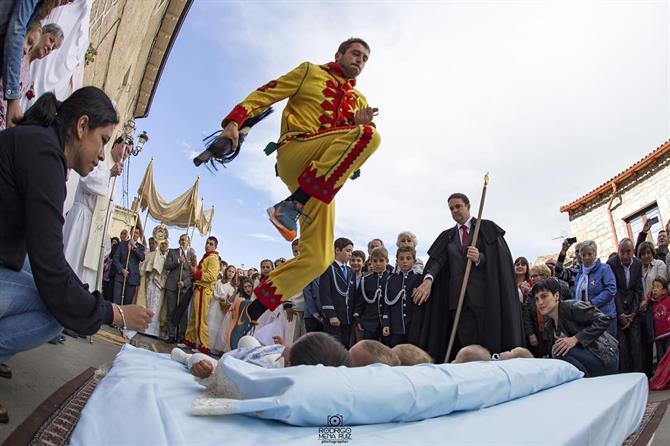With the start of the new year, we took the opportunity to make a list of all the weird festivals taking place in Spain. We found some truly weird and wonderful events which definitely deserved a list of their own.
The combination of the creative Spanish imagination, unknown local mysteries and the desire to always have a good time have resulted in some crazy and quirky celebrations full of joy and fun.
From crazy battles with tomato, wine and flour to dancing skeletons and human towers, here are 14 of the weirdest and wonderful events in Spain.
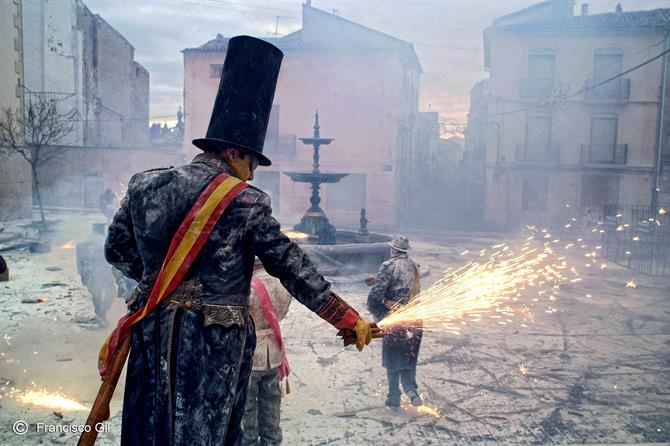
1. La Vijanera - Silió (Molledo), Cantabria
We decided to start our list with the first carnival of the year in Europe. La Vijanera is a colourful masquerade celebrated on the first Sunday of the year in the small town of Silió, Cantabria. During this traditional celebration, the locals dress as characters known as "zarramacos". This extravagant dress consists of colourful furs, big cowbells and weevils hats.
Each "zarramaco" has a specific role and together they tour the town of Silió hunting and banishing evil spirits. After reading the "coplas" - a humorous critique recalling the events of the prior year - comes the symbolic hunting and killing of the bear. This ritual symbolises the triumph of good over evil and is believed to bring good luck for the coming year. La Vijanera is a festival with everything: fun, superstition and lots of culture.
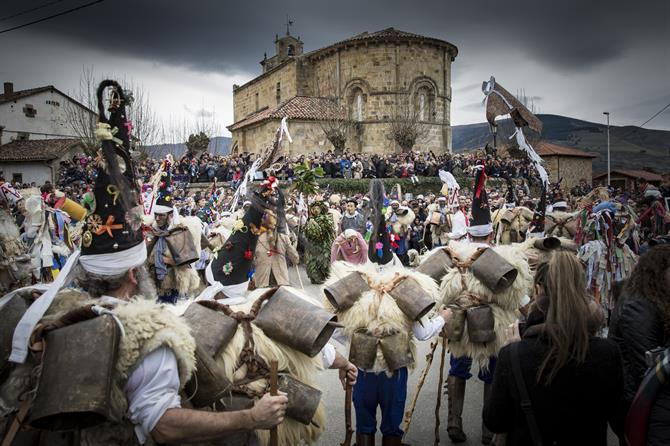
2. Las Fallas - Valencia
The festival of Las Fallas is further proof that in Spain they really know how to throw a party. Las Fallas is celebrated every year in mid-March throughout the city of Valencia and is a street party of humour, fire and gunpowder during which huge, brightly coloured papier-mâché "ninots" or statues, are set ablaze. Throughout the year, different organising committees build these statues from scratch, some of them measuring up to 20 metres high.
The satirically themed ninots are placed all over the city for people to enjoy before they are set alight and destroyed. Ninots of celebrities, politicians and even presidents have been portrayed and burned during this fun fiesta, only one is saved by the votes of the people and transported to the Fallero Museum.
You can find more information about Las Fallas in our guide to the loudest fiesta of Valencia.
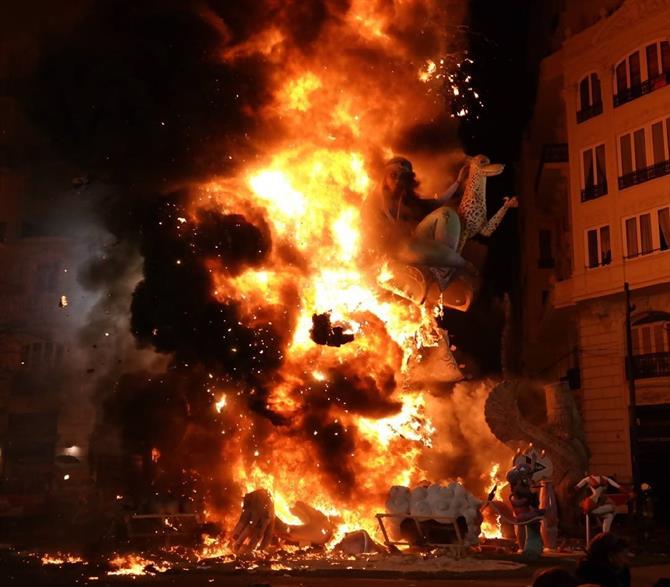
3. Festival of Santa Marta de Ribarteme - As Neves, Pontevedra
The Festival of Santa Marta de Ribarteme is a particularly peculiar festival where living survivors of near-death experiences are carried through the streets in open coffins. The relatives of the survivors carry the coffins to the church to show gratitude to the Virgin Mary for protecting their loved ones throughout these scary ordeals.
Santa Maria de Ribarteme is not the most typical of Spanish fiestas, but the after-party lightens the mood with fireworks, live music of various orchestras and good food.
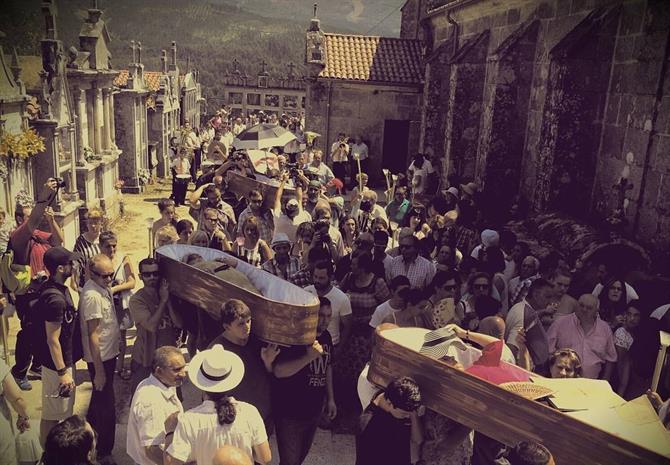
4. La Tomatina - Buñol, Valencia
La Tomatina is the world's largest tomato fight and is celebrated on the last Wednesday of August. This fun and refreshing festival takes place in the town of Buñol near Valencia. The small town of Buñol has just 9000 inhabitants but doubles in size during the famous event, during which more than 140 tons of overripe tomatoes are thrown at anything that moves.
In 2012, approximately 50,000 people wanted to participate in La Tomatina which forced the Buñol local government to put a 12€ minimum price tag on the party. Given the huge amount of eager visitors, it is now obligatory to buy a ticket well in advance.
During La Tomatina, it is almost impossible to find accommodation in Buñol, so it's a good idea to book some holiday accommodation in Valencia and save yourself a small fortune.
5. Human Tower Building Competition - Tarragona
Every other year, the city of Tarragona celebrates the world's biggest human tower building competition. The tradition of building these mesmerising 10 metre-high towers has a long history in Catalonia and dates back to the 18th century. The towers are made of people standing on each other's shoulders and usually, a small child climbs last to reach the tip of the trembling tower.
The human towers have been declared an intangible cultural heritage site by UNESCO. If you are unable to visit the Tarragona competition, you can find similar events all over Catalonia especially during local events such as La Mercé, Sant Jordi or La Diada where these human towers are built to entertain the crowds. If you want to have more space, privacy and money in your wallet, choose a holiday rental in Catalonia rather than a hotel.
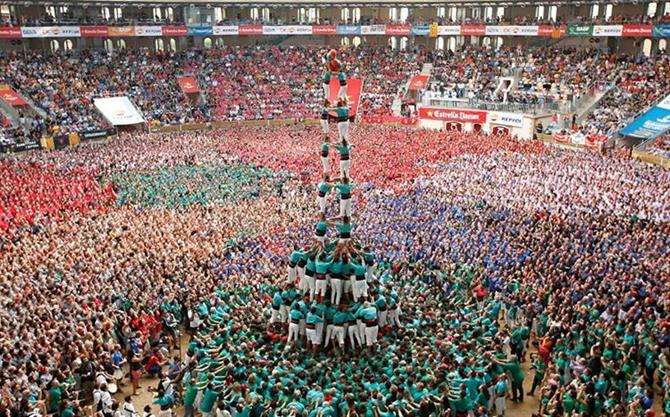
6. Wine Fight - Haro, La Rioja
If La Tomatina sounds messy to you, imagine starting a war with red wine! Rioja is one of the most well-known wines in Spain and the province of La Rioja celebrates a chaotic wine war to celebrate the area's global success as a wine producer.
According to a legend, during a pilgrimage to the hermitage of Los Riscos de Bilibio on June the 29th, a villager decided to refresh a travelling companion by pouring wine that he had carried in his boots all over him. This story created a fun tradition that is now one of the most visited festivities in Spain, in which more than 130,000 litres of wine is poured all over the revellers.
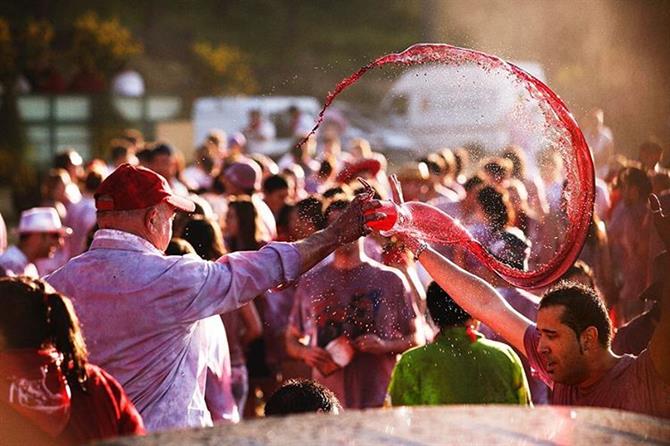
7. Cascamorras Festival - Guadix and Baza, Granada
The fiesta of Cascamorras is undoubtedly one of the funniest and dirtiest parties in Spain. The Cascamorras is a clown-like character from the village of Guadix who wears brightly coloured clothes and attempts to steal the valued statue of the Virgen de la Piedad from the neighbouring village of Baza on the 6th September. The locals try to prevent the Cascamorras' attempt by throwing thick black paint on him and chasing him all over the village. The rules of the game say that if the Cascamorras is able to steal the Virgin without getting his clothes dirty, he could take it to Guadix.
Nevertheless, the Cascamorras is always forced to return to Guadix with empty hands. The defeat antagonises the locals so much that the paint throwing manhunt continues and the poor clown has to run again.
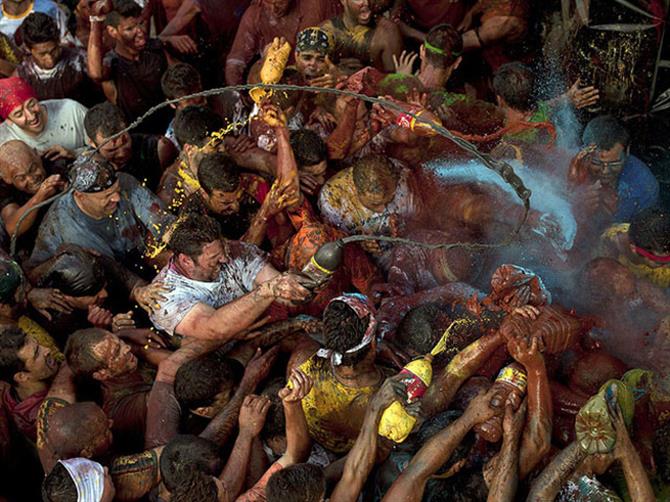
8. Flour Fight Festival - Ibi, Alicante
Every December 28th, the Enfarinats (the floured ones) impose a peculiar justice system on the locals in the main square of Ibi, Alicante by starting a hilarious battle of flour, eggs and vegetables.
The Enfarinats impose a series of absurd laws on the residents of Alicante. Whoever has the courage to break the laws is unofficially fined and will become the target of these flour bombs which are thrown all over the square. The money collected is donated to different charity organisations.
A ceasefire is agreed at lunchtime so partygoers can enjoy the fabulous food offered by the restaurants. Later, the battle continues with even more kilos of flour, gunpowder, dancing and good music.
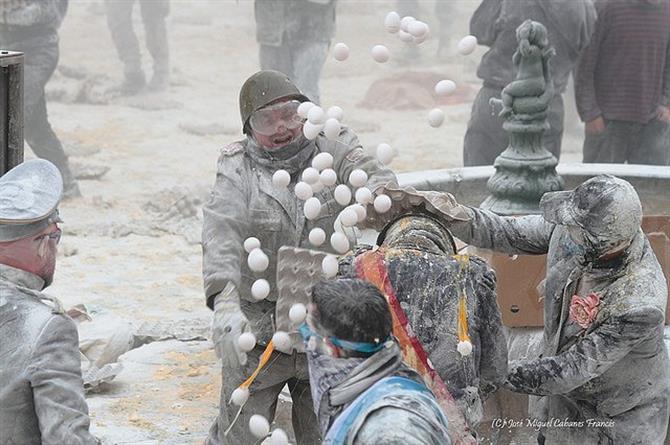
9. Filoxera Festival in Penedés, Catalonia
During the night of September 7th, people dressed as giants with huge heads dance quietly in Sant Sadurní d'Anoia, while huge wasps sneak around the streets of the village. The next day the wasp's attack and later on, a spectacular parade of fire, sparks and music takes place to celebrate their disappearance.
The Filoxera festival gives an idea of how the Penedés wine area once suffered from a wasp plague. The plague was the main reason that the area begun to produce more white grapes and later started to focus more on cava wines. If you'd like to know more about the cava traditions of Penedés, have look at our article about the cava route through Penedés.
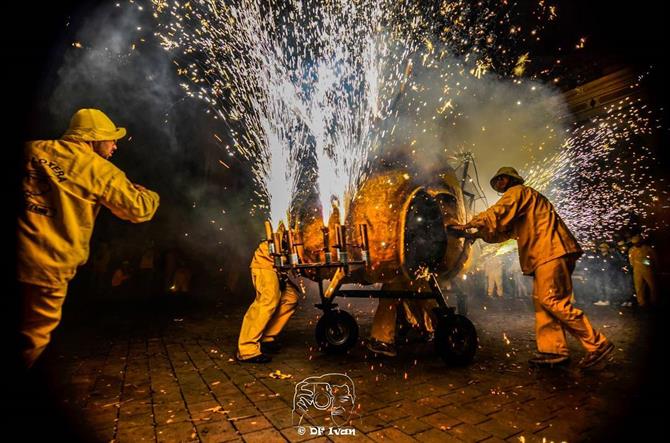
10. Tamborrada Drum Festival - San Sebastián
On 20th January, the vibrant city of San Sebastian starts one of the noisiest and entertaining festivals in the country: La Tamborrada. More than 15,000 locals gather together for one day to bang drums non-stop for 24 hours.
The origins of the celebration are uncertain. According to the most popular version of events, the tradition was started at the beginning of the 19th century, when Napoleon's troops invaded San Sebastian and the local women would mock the French soldiers who marched around the city streets by banging buckets. Today La Tamborrada symbolises the union of the inhabitants of San Sebastian and enhances the Basque identity.
Different culinary clubs have played a very important role in the promotion and success of La Tamborrada. That's why many drummers and locals wear chef uniforms or traditional Basque clothes during the festival.
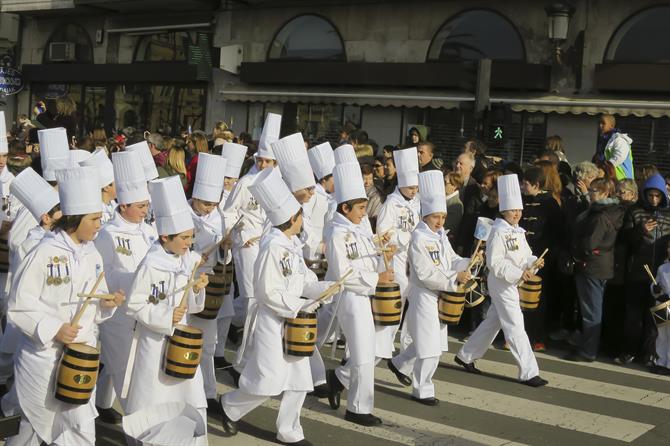
11. The Rafters of Nargó - Lleida
Can you imagine yourself gliding down the river in a wooden raft? This transportation method was widely used in Catalonia until the last century. The rafters or 'raiers' used to transport the wood from the Pyrenees, down the rivers and to the coast. Every third Saturday of August we can actually see how it happened.
For this special day, the locals wear traditional clothing in remembrance of the rafters who endangered their lives by guiding their rafts down the River Segre. This festival also showcases the amazing flavours of the local food scene.
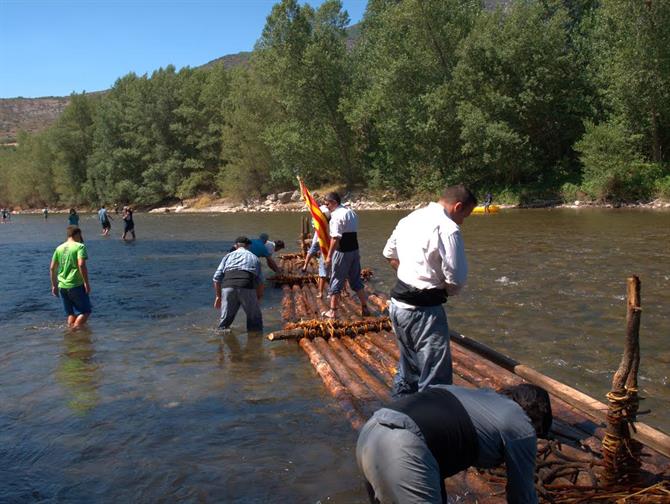
12. Dance of the Dead - Verges, Girona
Easter's Holy Thursday is celebrated in a macabre and peculiar way in Verges near Girona. The village organises a strange parade with dancing skeletons and drums. The Dance of the Dead is a theatrical representation with ancient symbolism.
In this creepy show five skeletons dance to the sound of a drum throughout the streets illuminated only by torches, the symbolic dance reminds us how limited our time in this planet is. If you plan to visit Verges, we recommend you to stay in a holiday home on the Costa Brava so that you can also discover other wonders of the area.
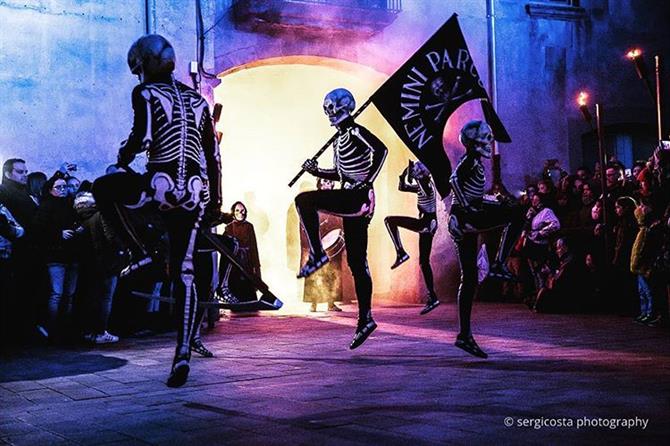
13. New Year in August - Berchules, Granada
Spaniards are famous for their desire to party and if a party needs to be repeated, it must be repeated! At least in Berchules, they think so, because every first Saturday in August, the new year's eve celebrations start all over again!
Due to an electricity cut in 1994, the inhabitants of Berchules couldn't carry out their new year traditions of good-luck grapes and partying and so they decided to celebrate the arrival of the new year in August instead.
The festival was so popular that it was repeated the next year and now attracts more than 10,000 people every year. Staying in Granada is a great idea if you want to visit Berchules, as this small town is located just on the other side of the Sierra Nevada. So, if your New Year bells start jingling earlier this year, head to the lovely village of Berchules!
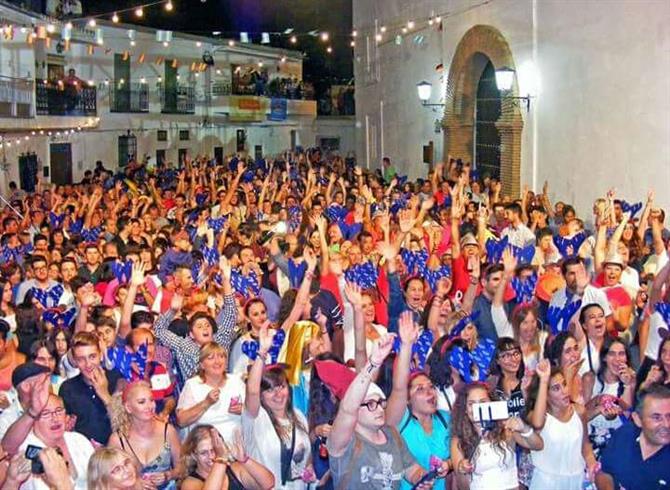
14. The "Salto del Colacho" - Castrillo de Murcia, Burgos
The "Salto del Colacho" is a tradition celebrated each year in June in Castrillo de Murcia, a small village in the province of Burgos. The festival, which dates back to 1621, combines Christian and pagan elements and celebrates the victory of good over evil.
The event revolves around a curious and spectacular show, probably unsuitable for apprehensive parents. At the end of a procession, a pastor blesses the children who were born in the local area during the previous year. The little ones are then laid on pillows and set in front of small altars decorated with flowers.
It is at this point that the "colacho" takes the scene. A man, dressed in red and yellow and representing the devil, runs through the streets of the village, hitting the attendees with a whip, and being in turn attacked with mocks and insults. Once he arrives in the area where the cushions and the children are placed, the "colacho" jumps over them to dispel any bad spirits and provide the babies with protection and health. At the end of the ceremony, children are sprinkled with flowers before returning to their parents' arms, and then the party begins with dances and wine.
Now that you are familiar with the funniest and most bizarre party excuses in Spain you can see that things can get pretty odd here. You must agree though that they do know how to throw a party!

